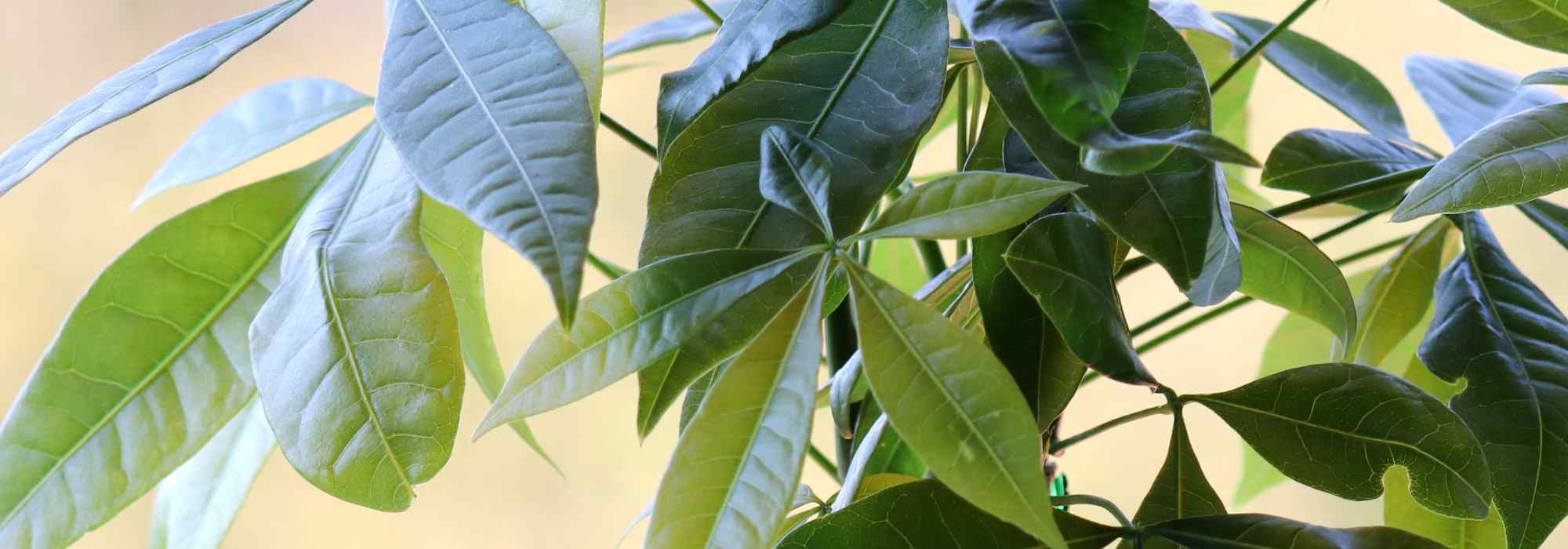
Pachira : planting, growing, and care
Contents
The Pachira in a nutshell
- This plant is prized for its lush foliage
- Its braided trunk gives it a unique and elegant appearance
- It grows quickly, offering a dense habit in no time.
- Very easy to care for, it adapts well to indoor conditions, tolerating different levels of light
- We love its Feng Shui lucky charm aspect!
The word from our expert
The Pachira aquatica, or Guiana chestnut, is a prized tropical houseplant known for its decorative braided trunk and lush foliage. Native to the wetlands of Central and South America, it adapts perfectly to indoor cultivation, provided it is placed in a bright space without direct sunlight. Its care is straightforward, but be careful not to overwater it, as excess moisture can cause root rot. Its thick trunk stores water, allowing it to withstand occasional missed waterings!
The indoor Pachira fits seamlessly into all décor styles, whether showcased in a stylish pot or paired with other tropical plants. In addition to adding an exotic touch to your home, it is renowned in Feng Shui for attracting luck and prosperity, hence its nickname “money tree.” Explore our collection and adopt your own lucky Pachira!
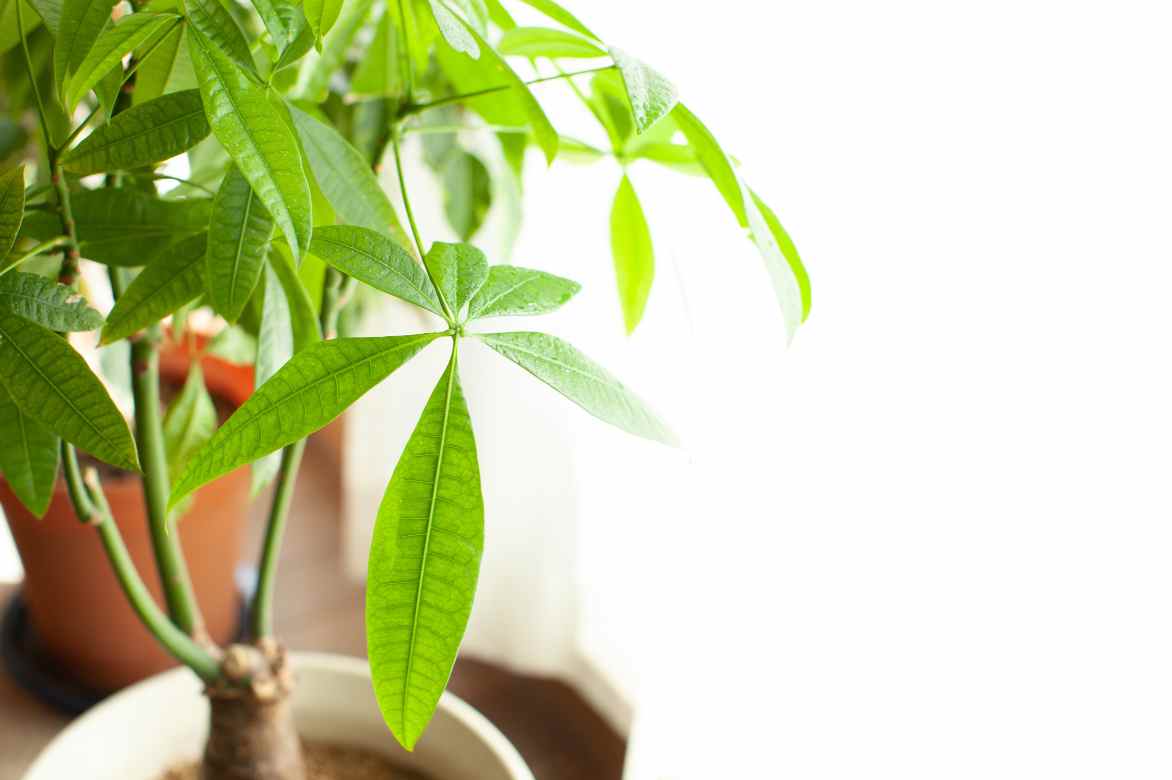
botany
Botanical data
- Latin name Pachira
- Family Malvaceae
- Common name Guiana Chestnut
- Flowering No flowering
- Height Between 2 and 3 m
- Sun exposure Bright
- Soil type Rich, well-draining and aerated substrate
- Hardiness Frost-sensitive
The Pachira belongs to the Malvaceae family, although it was once classified among the Bombacaceae. It is often called “Guiana Chestnut”, due to its edible seeds resembling chestnuts, but also “aquatic Pachira” or “money tree”, the latter nickname being linked to an Asian belief that it brings prosperity and luck.
Native to the tropical regions of Central and South America, it grows naturally in humid environments, along rivers and in swamps. Its thick trunk allows it to store water, making it particularly resistant to variations in humidity.
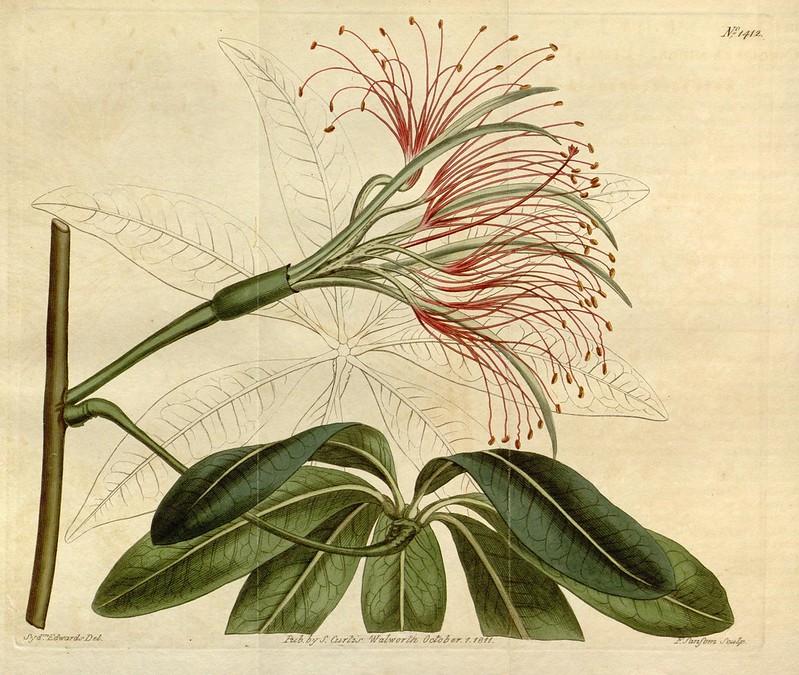
Pachira: botanical plate circa 1800
Today, the Pachira is cultivated as a houseplant due to its elegant foliage and great adaptability to indoor conditions. It tolerates indirect light and drier air than in its natural habitat. Indoors, a well-maintained Pachira can live for several decades, with an average lifespan of 10 to 15 years, or even longer if growing conditions are optimal. Its longevity depends mainly on the quality of watering, light exposure, and care provided, particularly avoiding overwatering, which can cause root rot. With regular repotting and good fertilisation, it can continue to grow and thrive for many years.
The most commonly cultivated species indoors is Pachira aquatica, recognisable by its often braided trunk and lush foliage resembling an open hand. The rarer Pachira glabra closely resembles it, but its leaves are slightly narrower and its trunk less swollen.
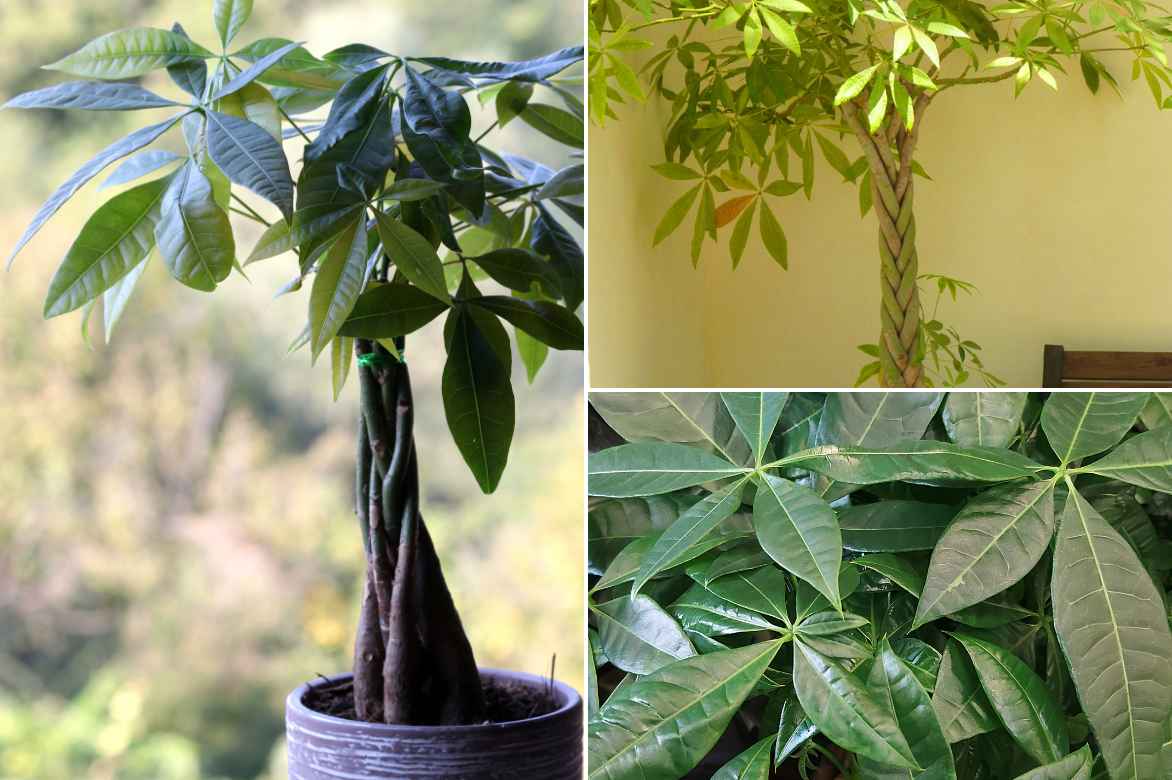
Pachira aquatica
The Pachira aquatica is a slender tree that can reach a height of fifteen to twenty metres in its natural habitat, although its indoor cultivation limits its growth to two or three metres. Its root system is fasciculate, spreading near the surface with a high absorption capacity, adapted to the humid environments where it grows naturally. The trunk, swollen at the base, allows it to store water, a characteristic that gives it good resistance to drought periods. When grown in pots, it is frequently braided for aesthetic reasons. The Pachira is sold in garden centres, usually composed of five braided plants together. This braiding method, which gives it an elegant and original appearance, is popular in Asia and the West. This practice also reinforces its symbolic aspect, particularly in feng shui, where braiding is sometimes associated with the union of elements and prosperity.
Its flexible and ascending branches bear evergreen foliage, composed of palmate leaves with five or seven oblong and glossy leaflets, of a vibrant green, whose arrangement gives the plant a harmonious and balanced silhouette. In tropical environments, the Pachira produces spectacular flowering with long, silky stamens, ranging from cream to reddish, releasing a delicate fragrance. However, indoors, flowering remains exceptional. When fruiting occurs, it gives rise to large, woody, ovoid capsules containing edible seeds resembling chestnuts.
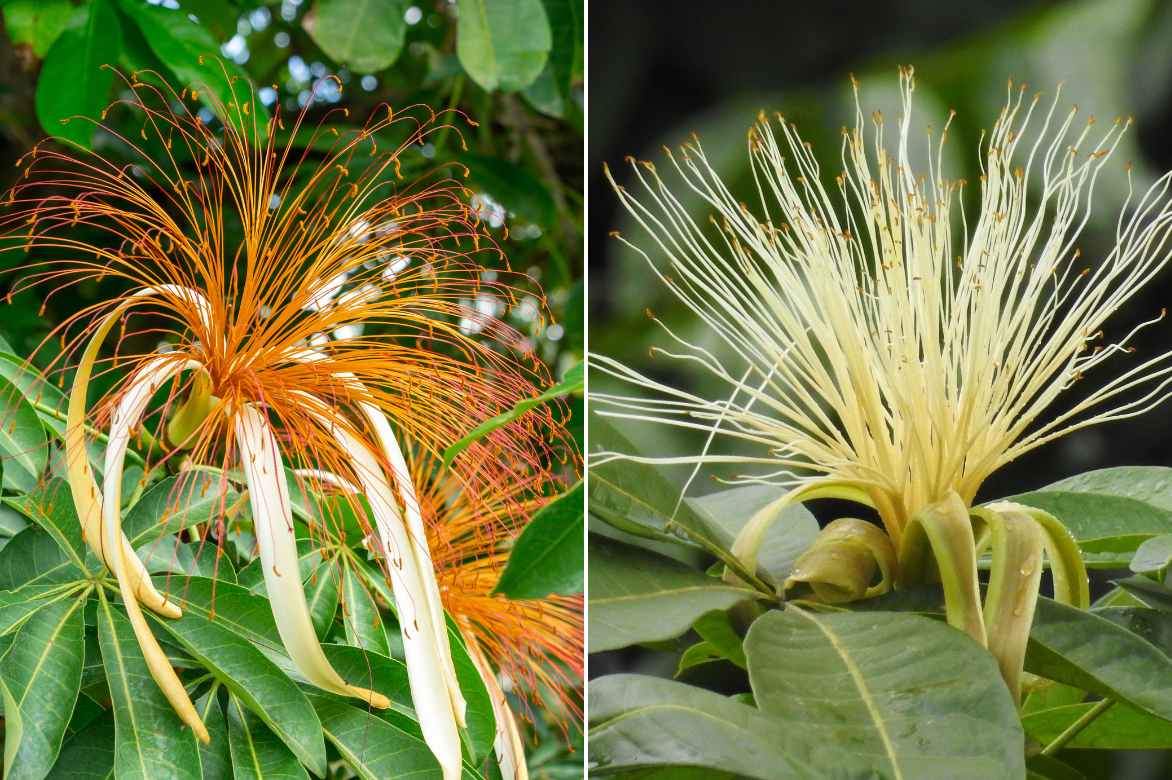
The extraordinary flowering of the Pachira only occurs in its natural habitat
It is often listed among plants with air-purifying properties. It is believed to absorb certain atmospheric pollutants such as formaldehyde or benzene, thereby helping to improve air quality.
Main species and varieties
Indoor cultivation
Where to Place a Pachira in Your Home?
The Pachira aquatica is a not very hardy plant, unable to tolerate temperatures below 10°C. Outdoor cultivation is only feasible in tropical or subtropical regions where temperatures never drop below 10 to 12°C. Elsewhere, it must be grown indoors or in a heated greenhouse to ensure its proper development.
The Pachira should be placed in a bright spot, but without direct exposure to sunlight, which could scorch its foliage. A well-lit room near an east or west-facing window is ideal to provide it with soft, indirect light. It can also tolerate filtered light, but its growth will be slower in overly shaded conditions.
The chosen location should also be protected from drafts and temperature fluctuations, as this tropical plant thrives in a stable environment, between 18 and 25°C. Avoid placing it too close to a radiator or heat source, as excessively dry air could damage its foliage. It requires a good level of humidity in the air. A living room, office, or even a heated conservatory in winter are perfect spots, provided you maintain good humidity levels, for example, by placing a container of water nearby.
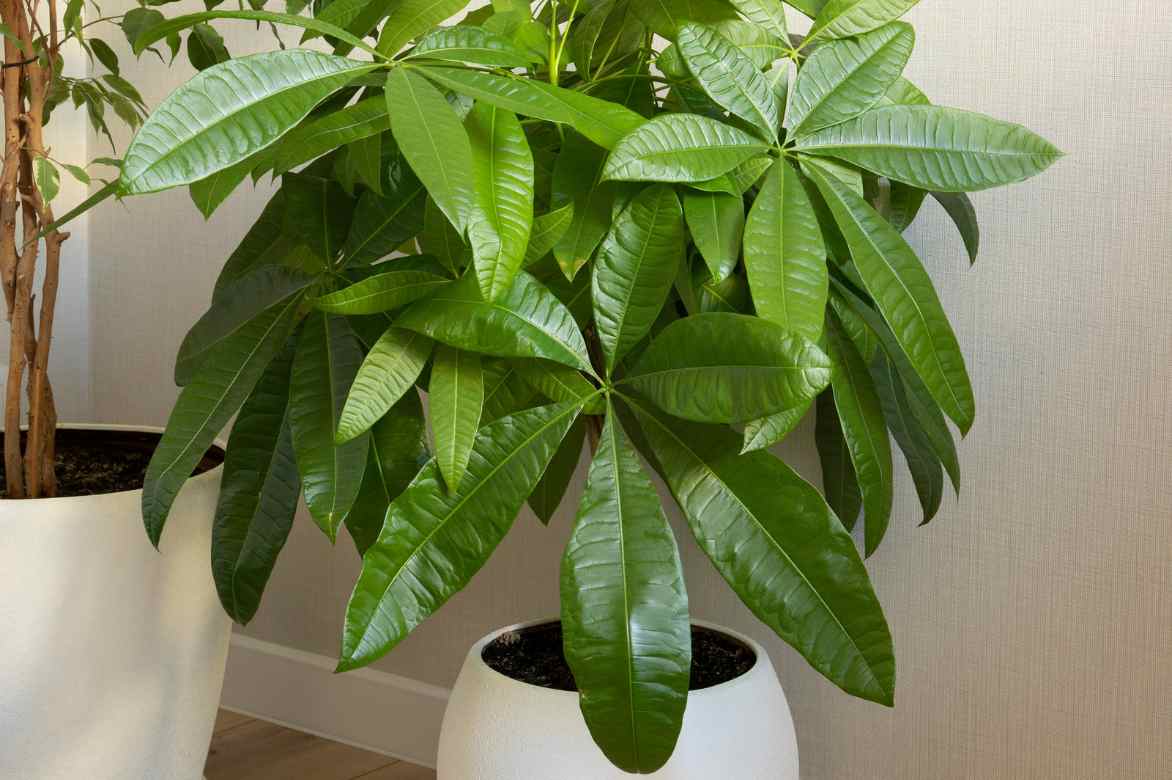
When to Plant It in a Pot?
The Pachira can be potted all year round, provided it is done in a stable indoor environment, free from drafts or temperature fluctuations, to avoid unnecessary stress.
Planting the Pachira in a Pot
To ensure the Pachira grows well, it is essential to choose a well-draining substrate, a suitable pot, and follow a few steps during planting.
Ideal Substrate
The Pachira prefers a light, well-draining, and slightly acidic to neutral substrate. A well-draining mix of indoor plant compost and perlite is ideal. Adding clay pebbles or gravel at the bottom of the pot improves drainage and prevents excess moisture, which could cause root rot.
Choosing the Pot
A pot with a drainage hole is recommended to avoid water stagnation. The pot size should be slightly larger than the root ball, but not too big to prevent excess moisture in the substrate. A diameter 3 to 5 cm larger than the root ball is sufficient.
Planting Steps
- Place a layer of clay pebbles or gravel at the bottom to ensure good drainage.
- Add a first layer of the prepared mix, lightly pressing it down.
- Carefully remove the plant from its old pot, taking care not to damage the roots. If they are root-bound, gently loosen them.
- Position the Pachira in the centre of the pot and adjust the height so the collar (base of the trunk) is level with the pot rim.
- Fill with the mix until the roots are covered, then lightly press to ensure good contact.
- Water lightly to moisten the substrate without soaking it. Water should drain out of the hole.
- Place the Pachira in a bright spot, away from direct sunlight, and avoid moving it abruptly in the following days to help it acclimatise.
How to keep a beautiful Pachira indoors?
Care
The Pachira is a relatively easy-to-care-for houseplant, provided its watering, fertilisation, and repotting needs are met.
Watering: How and How Often?
The Pachira stores water in its trunk, allowing it to better withstand dry periods. It is therefore important to avoid overwatering, which could lead to root rot. Similarly, the foliage should not be misted.
- Spring and summer: Water once a week, ensuring the substrate dries slightly between waterings. Water should not stagnate in the saucer.
- Autumn and winter: Reduce watering to every 10 to 15 days, as the plant enters a dormant phase and consumes less water.
Always use water at room temperature and, if possible, non-calcareous (rainwater or filtered water) to prevent white spots from appearing on the leaves.
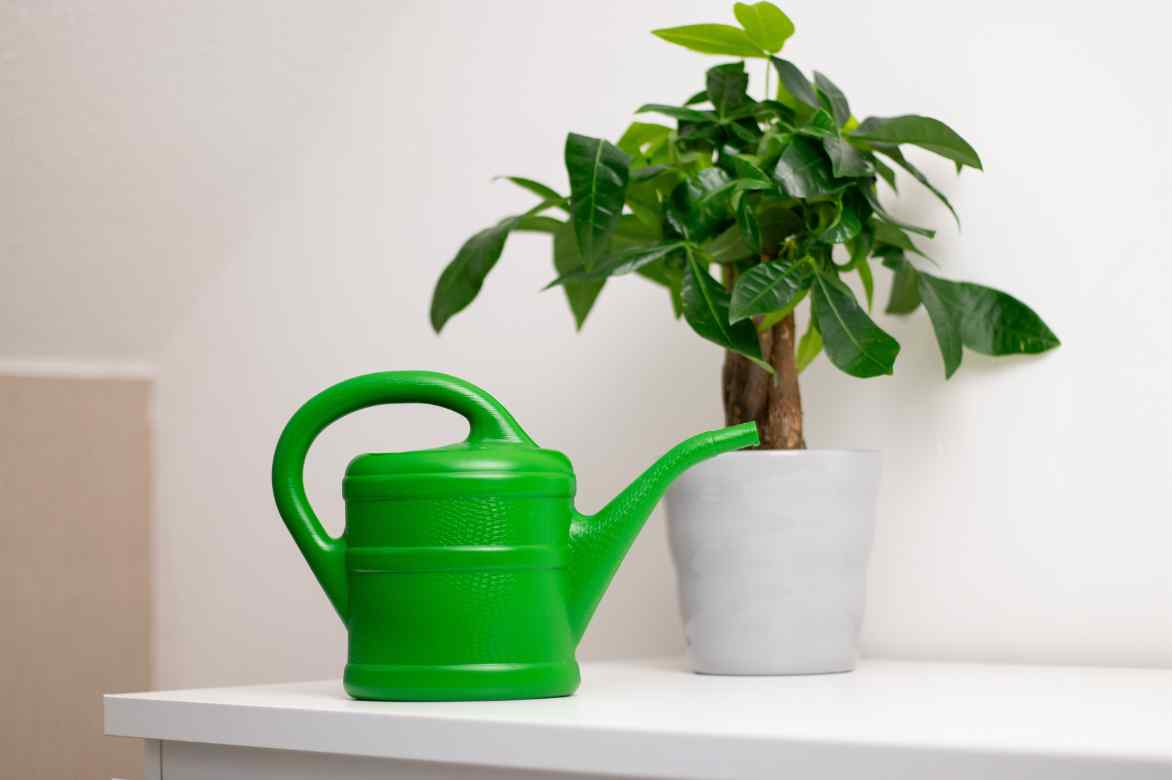
Fertilisation: Which Fertiliser and How Often?
During the growth period, from March to September, apply a balanced liquid fertiliser every three weeks. A balanced fertiliser, rich in nitrogen (N), phosphorus (P), and potassium (K), will promote dense and healthy foliage. In winter, fertilisation is unnecessary, as the plant naturally slows its growth.
Pruning: Is It Necessary?
The Pachira does not require regular pruning, but it can be pruned in spring to give it a more balanced shape or limit its growth. Simply cut back overly long, yellow, or bare stems with clean, sharp pruning shears. Cut just above a node (the point where a new leaf emerges). This pruning also encourages the development of new shoots and denser foliage.
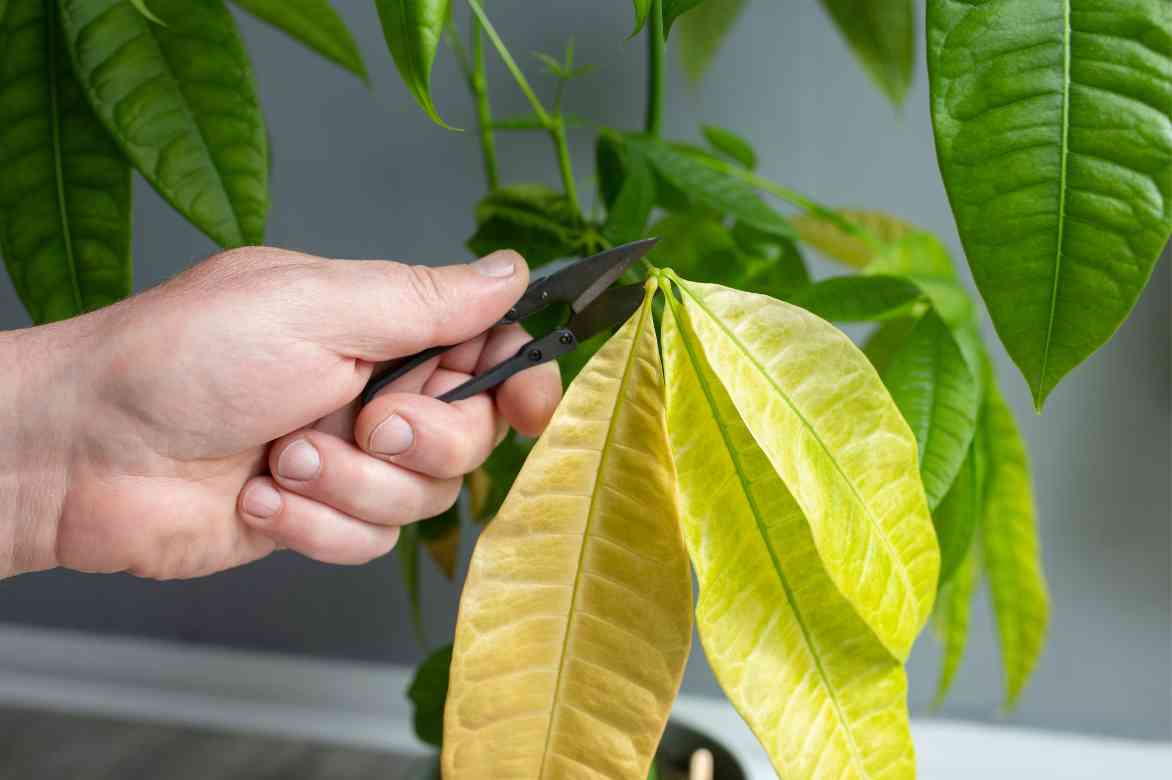
Why Braid a Pachira?
The braided Pachira is often associated with feng shui beliefs. Braiding multiple trunks symbolises unity and strength, enhancing its image as a good luck charm. From a botanical perspective, this practice does not affect the Pachira’s growth, provided the braiding is done correctly and the trunks are not too tightly bound, which could hinder their development. It is possible to braid a Pachira yourself, but this should be done on young plants with trunks that are still flexible. Braiding is a delicate process that requires time and patience, as the trunks continue to grow together over the months. Olivier explains how to braid a Pachira yourself.
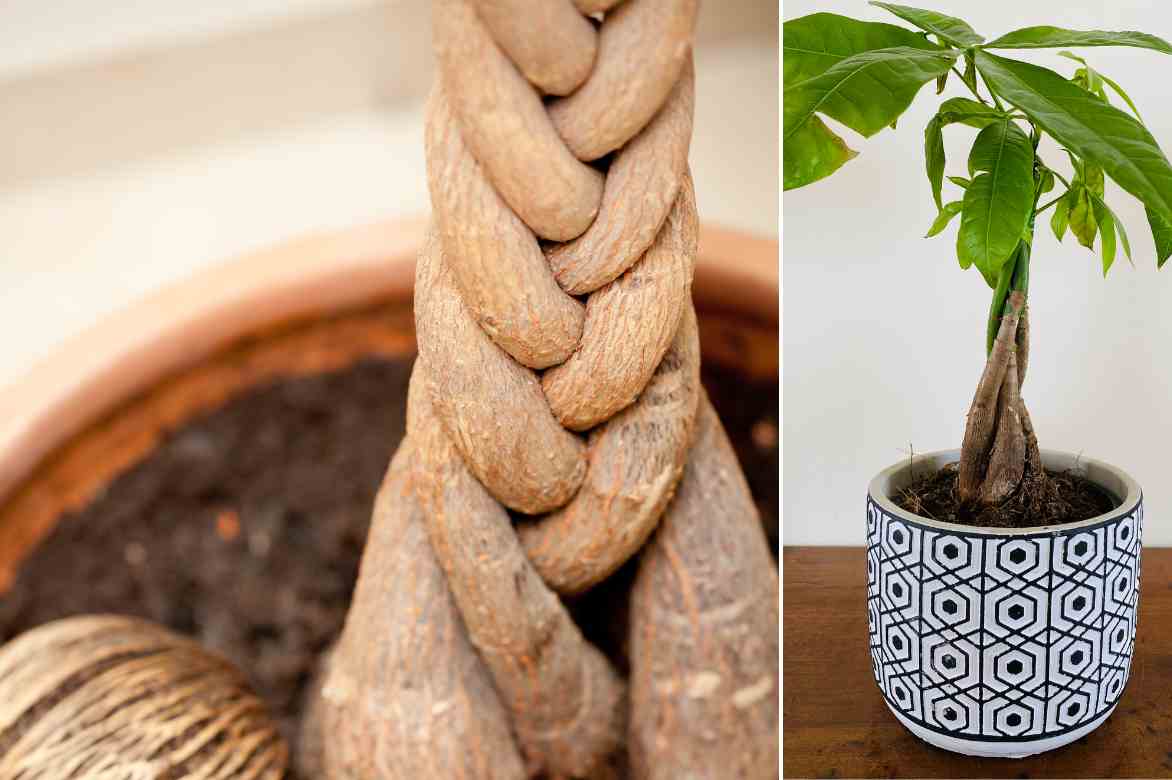
When and How to Repot It?
The Pachira should be repotted every 2 to 3 years, preferably in spring, when growth resumes.
- Choose a slightly larger pot with good drainage.
- Use a light, well-draining substrate, such as a mix of houseplant compost, perlite, and sand.
- After repotting, wait a week before watering to allow the roots time to heal.
Learn more in our guide: Repotting a Houseplant.
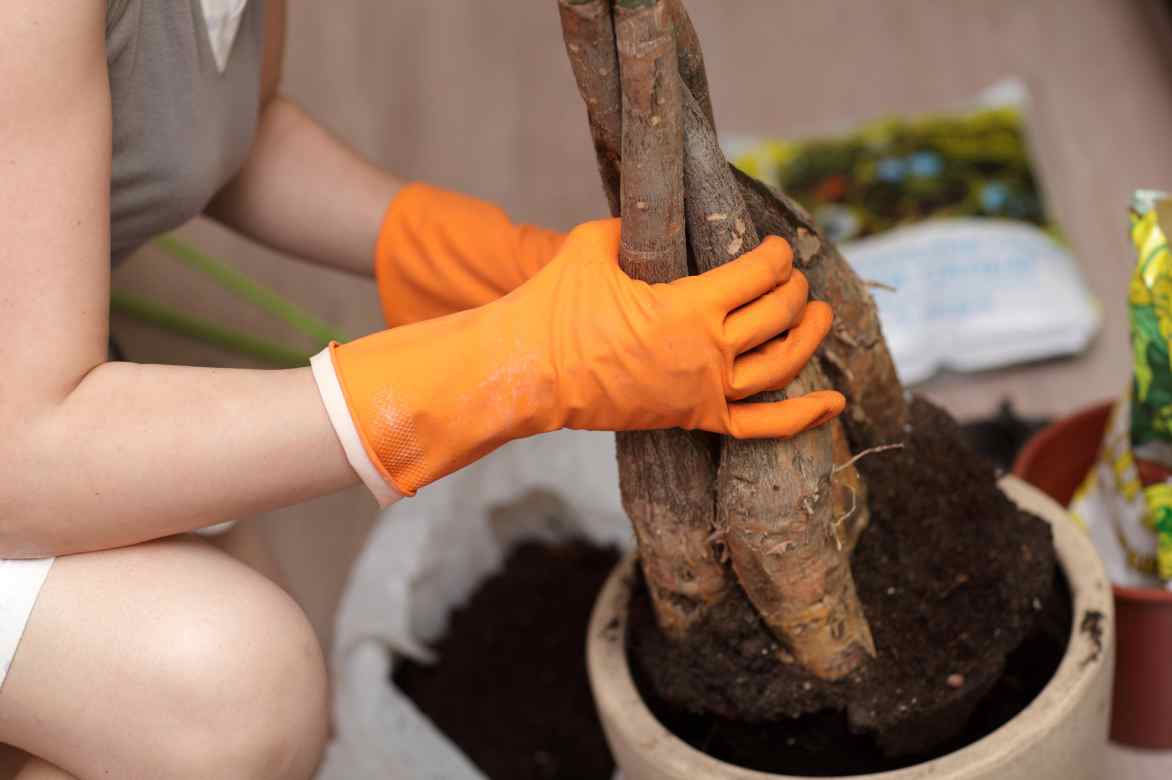
Common Diseases and Parasitic Pests of the Pachira
The Pachira is a robust plant, but it can be prone to certain diseases and parasitic attacks, especially when grown indoors under unsuitable conditions.
Common Diseases
- Root rot: caused by overwatering or poor drainage, it manifests as wilting of the leaves and a softened trunk. It is crucial to reduce watering and, if necessary, repot the plant in a dry, well-draining substrate.
- Leaf spots: brown or black spots on the leaves may indicate a fungal infection, often caused by excessive humidity. Improve ventilation and avoid wetting the foliage when watering.
Common Parasites
- Scale insects: small cottony clusters or brown shells on the stems and undersides of the leaves. They weaken the plant by sucking its sap. You can remove them with a cotton pad soaked in 70° alcohol or apply diluted black soap.
- Spider mites: tiny red mites that spin fine webs under the leaves, especially in dry air. Increasing ambient humidity and spraying water on the foliage can help prevent their appearance.
- Aphids: small green or black insects that colonise young shoots. A treatment with black soap or a lukewarm shower for the plant can eliminate them.
Good prevention involves proper care: moderate watering, good ventilation, and regular inspection of the foliage can prevent most problems.
→ Read also: How to get rid of aphids on indoor plants?
How to take a cutting from a Pachira?
The simplest method to propagate a Pachira is stem cutting propagation, which yields good results when carried out in spring or summer, during the plant’s active growth period.
Steps to propagate a Pachira by cuttings
- Take a cutting: Cut a healthy stem about 15 to 20 cm long with clean, sharp pruning shears. The stem should have at least 2 to 3 nodes and a few leaves.
- Remove the lower leaves: To reduce evaporation and encourage rooting, keep only the upper leaves.
- Let the cut dry: Leave the cutting exposed to air for a few hours so the wound can heal slightly, reducing the risk of rot.
- Plant the cutting: Insert the base of the stem into a light, well-draining mix, such as a blend of compost and perlite or sand.
- Maintain consistent moisture: Water lightly and cover with a transparent plastic bag or a mini greenhouse to create a greenhouse effect and promote rooting.
- Place in a bright, warm spot: A temperature of around 25°C is ideal. Avoid direct sunlight.
- Wait for rooting: The first roots usually appear after 4 to 6 weeks. Once the cutting is well-rooted, it can be repotted into a permanent pot.
The Pachira, the green decorative touch
With its elegantly braided trunk and lush foliage, the Pachira brings a refreshing and zen touch.
A strategic location
To reveal its full potential, place your Pachira in a bright space near a window that filters the light. In a living room, hallway, or even an office, it immediately catches the eye and gives a sense of freshness and elegance. It pairs particularly well with minimalist, contemporary, or bohemian interiors.
A pot that makes all the difference
Don’t underestimate the power of a pretty planter! For a natural and warm look, opt for a wicker basket or a terracotta pot. If you prefer a minimalist and modern style, choose a matte ceramic, concrete, or black metal design.
Pair it with other plants for a jungle effect
The Pachira loves company! Pair it with an XXL Monstera, indoor ferns, or graphic calatheas to create an ultra-trendy jungle corner. For an interesting contrast, play with heights by combining it with cacti or small succulents placed on a nearby shelf.
The Pachira has everything to charm. Will you succumb to its exotic allure to brighten up your interior?
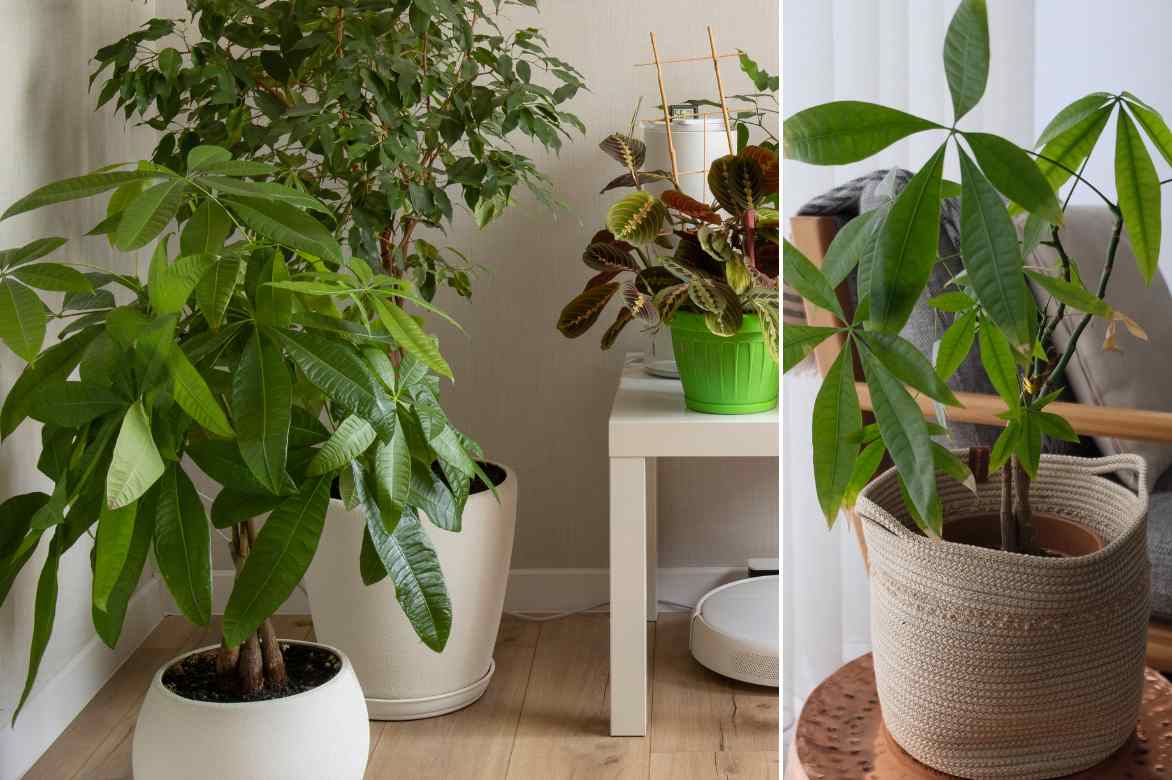
Useful resources
→ Discover our wide range of houseplants.
→ Many books on houseplants exist, but we recommend: The Encyclopedia of Houseplants by Solène Moutardier, published by Ulmer.
Frequently asked questions
-
Why is my Pachira losing its leaves and turning yellow?
The yellowing and falling of the leaves of your Pachira can be caused by overwatering, insufficient light, or draughts. Ensure the pot has good drainage, the plant receives enough indirect light, and avoid sudden temperature changes. If only the leaves at the base are falling, it may be a natural renewal process, especially if new shoots are appearing.
- Subscribe!
- Contents
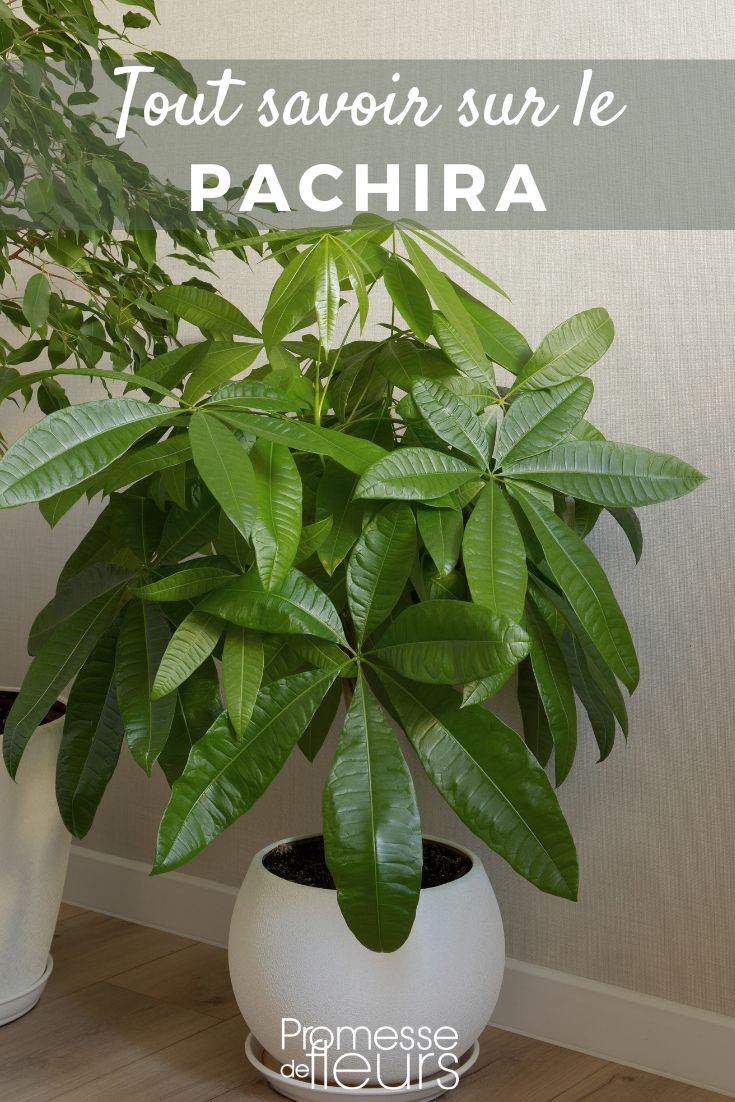































Comments